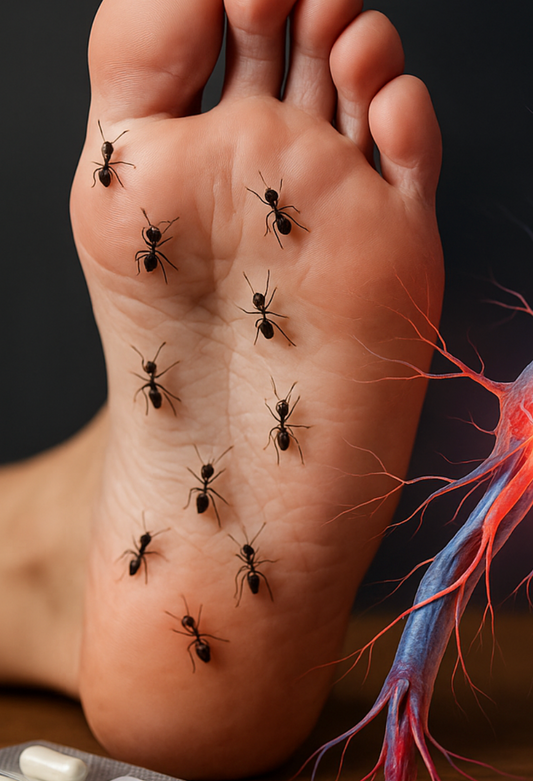How visualization exercises and mental coaching can help
Mental training is often referred to as a secret weapon in sports, rehabilitation and chronic pain management. But what exactly is behind the idea that mental coaching or certain visualization exercises can have a positive effect not only on the psyche but also on physical processes? You may have heard that top athletes go through their competition scenarios in their minds before they even step onto the real track or field. In fact, more and more studies suggest that visualization and similar techniques can be effective far beyond top-level sport, even in areas such as pain therapy, stress reduction or dealing with nerve disorders. In this article, we will look at what mental training actually is, how it affects the body and nerves, what scientific findings underpin these methods and how you could benefit from such exercises in your everyday life.
What is meant by mental training
Mental training refers to techniques that use the imagination and psychological control of processes in the body to specifically influence behavior or sensations. The spectrum ranges from simple visualization exercises to complex programs in which a coach or therapist guides you to consolidate certain thought patterns. The core of the matter is always a type of imagination or inner images that you use to program your brain for certain goals.
How exactly this works is the subject of current research. One hypothesis is that when you intensively imagine a situation, the brain shows similar activity patterns as when you actually perform it. A study published in the journal for neurological research (2017) used imaging techniques to show that in people who only imagined a sequence of movements in their minds, very similar areas of the motor cortex were active as in people who actually performed the movement. This suggests that just by imagining exercises, neural circuits are activated that are responsible for implementation in the body. For you, this could mean that you can stimulate your nerves and muscles through mental training without doing any physical activity.
Mental Training for Physical Disorders
You might think that mental training is more for competitive athletes who want to perfect their routines. But more and more people are using visualization techniques or mental coaching to better deal with pain or chronic illnesses. The idea is that pain is not just a physical phenomenon, but is strongly influenced by cognitive and emotional factors. If you learn to mentally "reinterpret" the painful sensations or focus intensively on relaxation, the brain can transmit fewer pain signals.
A randomized controlled study published in 2019 in the journal Pain Practice followed people with chronic back pain who regularly used mental training in the form of visualizations and breathing techniques over three months. For example, they were asked to imagine their muscles relaxing and healing warmth flowing through their spine. Compared to the control group, they reported significantly fewer episodes of pain and a reduction in the use of painkillers by around 30 percent. What can be concluded from this is that mental images apparently help to put your nervous system into a kind of calming mode, so that the transmission of pain in the brain is no longer as strong.
How your nervous system benefits from it
The human nervous system is not a rigid structure, but rather flexible. People often talk about "plasticity," or the ability of nerves to adapt to changing requirements. In fact, certain areas of the brain respond to repeated mental training by creating new connections. For example, if you regularly imagine your feet relaxed and pain-free, this mental stimulus can influence the system of nerve cells that is normally responsible for transmitting pain impulses.
In addition, mental training often reduces stress hormones. A study in the European Journal of Applied Psychology (2018) showed that in subjects suffering from a chronic nervous disease, regular use of relaxation and visualization techniques led to a reduction in the level of the stress hormone cortisol. Less cortisol in the blood means less alertness, which can break the vicious cycle of pain and tension. This in turn protects your nerves because the constant barrage of stress signals decreases.
Visualization exercises in practice
One of the most well-known forms of mental training is what is known as "imagery." You sit quietly, close your eyes, and try to create a scene or feeling in your mind's eye as vividly as possible. Maybe you choose a situation in which you feel free of discomfort, or even train your running ability or strength even though you can't run or do strength training right now. Athletes often use this technique by imagining themselves performing a perfect movement. In a study from the journal Psychology of Sport and Exercise (2020), high jumpers were able to improve their performance by around five percent through intensive mental training, even though they had not changed their physical training.
It can work in a similar way for people with nerve disorders. Imagine walking pain-free and light as a feather through a pleasant park or meadow. You feel the ground soft and without any stinging or tingling. This may sound like wishful thinking, but with regular practice your brain can simulate the movements and sensations, so to speak. This sends signals to your motor and sensory center that suggest a kind of "pain-free option" to the body. Of course, this is no substitute for real therapy, but it can be a powerful addition that helps calm the nervous system and provide positive stimuli.
Mental Coaching against Stress and Pain
In addition to visualization, there are other approaches that can help you deal with pain or nerve diseases. Mental coaching means that a professional coach or therapist guides you to respond better to your feelings using certain psychological strategies. One example is cognitive restructuring, where you learn to replace negative or fearful thoughts with more neutral or confident beliefs. People who suffer from chronic pain can get caught in a negative thought spiral ("The pain never stops," "My life is ruined"). Such thoughts activate the stress system, which can make the pain worse. Coaching aims to break these thought spirals and promote relaxation. Studies, for example published in Behavior Therapy (2019), showed that people with chronic pain who went through a mental coaching program used less painkillers and had a higher activity level than a control group.
Another area is relaxation techniques such as breathing exercises, progressive muscle relaxation or meditation. Although this is not always strictly "mental coaching", all of these techniques rely on controlling internal processes through conscious concentration. By learning to direct your attention - to your breath, an inner image or a certain physical sensation - you gain control over negative thought patterns and reduce activity in the pain processing center. A meta-analysis in the journal Pain (2018) confirmed that regularly practiced mindfulness meditation can subjectively reduce pain intensity by up to 25 percent, measured using standard pain scales.
Current research results
For several years now, there has been growing evidence that mental training can be used successfully in the rehabilitation of patients with nerve or muscle diseases. A randomized controlled study in a European journal of rehabilitation (2020) examined people who suffered from unclear sensory disturbances in their legs. The subjects who mentally practiced a short sequence for ten minutes a day - they imagined themselves walking safely and without pain - showed better gait stability after four weeks than those who only did traditional physiotherapy without visualization. The authors suggested that this mental preparation stimulates the nerve pathways and reduces faulty circuits.
Visualization and mental coaching are also being increasingly researched in relation to neuropathic pain, such as that which occurs in diabetes or after chemotherapy. A study from the USA, published in the Journal of Pain Management (2019), reported on a small pilot project in which patients with very unpleasant sensations in their feet and hands completed mental training over five weeks. They learned to imagine warmth and blood circulation in the affected regions. At the end, 60 percent of them stated that their symptoms had significantly improved, even though they had not changed their medication.
Everyday tips for your mental training
If you are curious about how you can integrate mental training into your daily routine, here are a few suggestions:
First, familiarize yourself with relaxation and breathing exercises. Find a quiet place, breathe deeply through your nose, pause for a moment and then breathe out slowly through your mouth. Repeat this a few times and try to build up an inner calm.
Secondly, choose a clear goal or image. For example, this could be imagining yourself walking along a pleasant path without pain, moving your hands powerfully and sensitively, or sitting relaxed without any unpleasant sensations. Include as many details as possible in this image: colors, sounds, feelings.
Third, stick with it. Mental training only becomes effective with regularity. Many people find it best to practice in the morning right after waking up or in the evening before going to sleep. If you do it every day, your brain will learn to activate this state more quickly.
Fourth, combine your mental training with other therapy measures. For example, if you have physiotherapy, you can mentally imagine before the session how your muscles work together optimally or how you perform certain movements smoothly. According to a study in a specialist rehabilitation journal (2017), people who supplement their conventional training with mental exercises show faster progress than those who only do physical exercises.
Fifth, don't be afraid to seek professional help. A coach, therapist or psychologist can help you to keep track of questions or difficulties and to work out the right techniques for you. Especially for people with chronic pain or serious nerve damage, it is worth tackling the whole thing in the context of comprehensive care.
Limitations and possible concerns
As exciting as mental training methods are, they are no substitute for medical examination or traditional treatment for serious illnesses. If your symptoms become more intense or you notice that none of the techniques are working, you should definitely speak to a specialist. Mental training should also not be misunderstood as "it's only psychological, you're imagining it." Pain and nerve damage are real, but our brain plays a key role in processing it. Mental training offers opportunities to consciously use this knowledge for ourselves, without saying that the pain is just imaginary. A study in the Journal of Pain (2016) warned against making too many promises of healing. Although mental training can be a huge help for many, not everyone responds to it in the same way and with some illnesses, significant symptom relief is more difficult to achieve. Nevertheless, the authors recommend considering it as a supplement to the overall treatment plan, as in many cases it does bring significant improvements or at least makes it easier to deal with symptoms.
Conclusion
Mental training includes visualization exercises, mental coaching and other techniques designed to enable your brain to control healing or pain-relieving processes. Various studies from sports science, pain therapy and neurology indicate clear benefits when it comes to calming or activating the nervous system. People with neuropathic pain, numbness or declining strength can benefit from visualization exercises that simulate movements or project pain-free states. The brain responds to these mental inputs by using certain nerve pathways and reducing stress hormones.
At the same time, mental coaching can help to break negative thought patterns that often reduce the quality of life even further in cases of chronic complaints. The key, as is so often the case, is regularity and the right technique. Those who consistently incorporate the exercises into their everyday lives often notice changes after just a few weeks, whether it be better pain management, increased mobility or new self-confidence in dealing with physical limitations. Of course, none of this is a substitute for thorough diagnostics or medical treatment. But as a complementary measure, mental training and visualization exercises have considerable potential to support nerves, reduce pain and thus achieve an overall higher quality of life.















